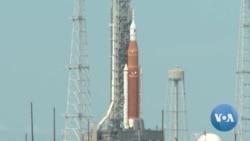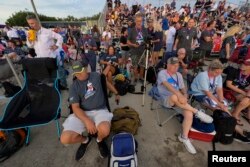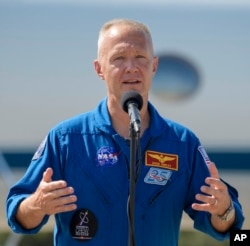Hoping to witness the launch of NASA's Artemis 1 rocket to the moon is – so far – an exercise in frustration for Mark Franko.
"I was hoping to feel the noise and the power and the sound – it would have been pretty interesting to see, I think," Franko told VOA as he and his friends tried to watch a launch behind a local restaurant not far from Cape Canaveral. But fuel leaks and other issues have twice postponed the most powerful rocket system ever created from taking off.
Despite the delays, Franko's friend, Mary Jane Patterson, thinks NASA shouldn't be in a hurry to make the next launch attempt.
"I think that they should bring it back to the building and really check it out completely and then go again. I feel like it was too soon to go off after the first problem, and I think that, whether it was PR [public relations] or whatever, they were trying to push the envelope but at the same time they can't. I don't think you can be too cautious," she said.
"It's the first time we've flown this rocket and this capsule," noted astronaut Stan Love, who spoke with VOA ahead of the first unsuccessful launch attempt. "There are many, many things that can go wrong. This is a test flight. Don't get your expectations too high."
But with hundreds of thousands of tourists gathering in Florida for each launch attempt, joining media from around the world assembled at Cape Canaveral, Love knows those expectations are high, at least partly because of the large price tag of the endeavor.
The original cost for the S-L-S, or "Space Launch System," which includes the rocket and boosters that propel the Orion capsule into space, has grown from $10 billion to $20 billion. Each successful launch will cost about $4.1 billion. NASA's inspector general expects the overall Artemis program to reach $93 billion by the time the first astronauts return to the surface of the moon, targeted for 2025.
That's if NASA can get the first uncrewed mission off the ground this year.
"We've got to make sure the vehicle is ready to go, we've got to make sure it's safe for crew, and those things just take time," said Doug Hurley, a retired NASA astronaut who flew on the first crewed mission of Space X's Crew Dragon capsule to the International Space Station. He now works for Northrop Grumman, one of the contractors working on Artemis, and he is quick to respond to critics who say the current effort to return to the moon is behind schedule and over budget.
"I've heard that my whole career. Every aircraft I've been involved with, every spacecraft I've been involved with. We heard that with Crew Dragon flying – it was six years from the time the contract was awarded to the time we flew. It takes time to build these complicated machines. But it's worth it."
As NASA troubleshoots difficulties while carefully weighing the risks in launching Artemis, cost isn't the only factor.
"Mission success comes as we assess the flight after the fact," said David Reynolds, a deputy program manager for NASA, who added that the future of spaceflight depends on the performance of this first uncrewed attempt to return to the moon.
"As you tick off the different boxes, you buy down a certain amount of risk for the crewed flight. And so, once you have made that determination and we decide that it is safe enough to fly with crew, we will have considered it a mission success."
But Mark Franko, who had to return to Tempe, Arizona, before the next potential launch, wonders if the effort to see Artemis 1 in person was worth it.
"If you watch it on TV it would probably be closer," he told VOA.
NASA is now looking at launch windows in late September and early October.













